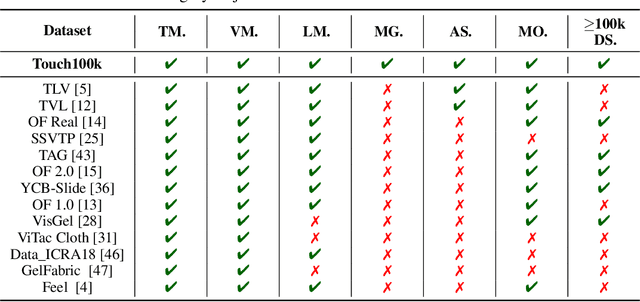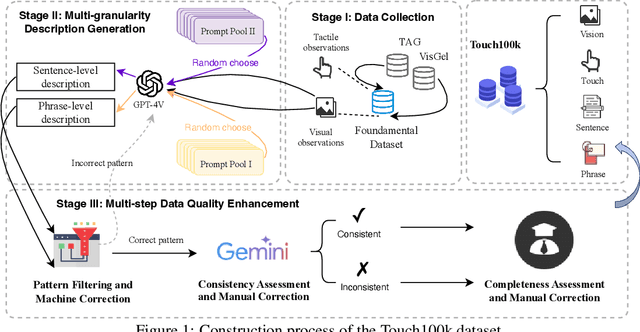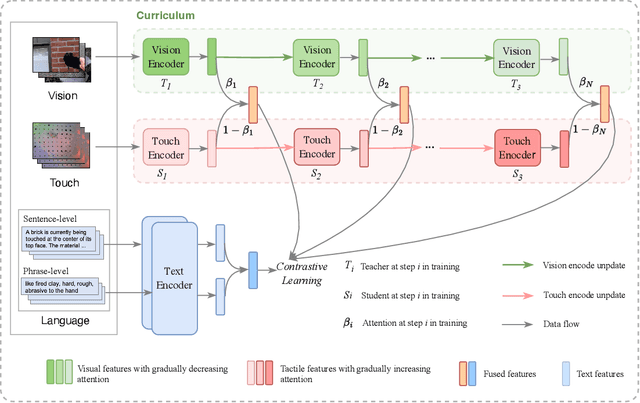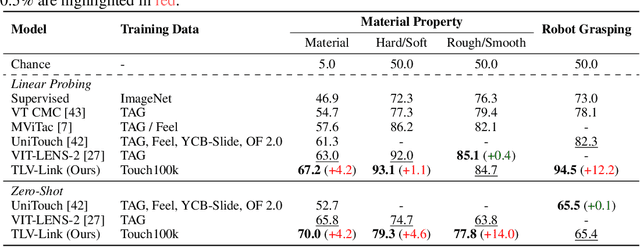Bin Fang
CLTP: Contrastive Language-Tactile Pre-training for 3D Contact Geometry Understanding
May 13, 2025Abstract:Recent advancements in integrating tactile sensing with vision-language models (VLMs) have demonstrated remarkable potential for robotic multimodal perception. However, existing tactile descriptions remain limited to superficial attributes like texture, neglecting critical contact states essential for robotic manipulation. To bridge this gap, we propose CLTP, an intuitive and effective language tactile pretraining framework that aligns tactile 3D point clouds with natural language in various contact scenarios, thus enabling contact-state-aware tactile language understanding for contact-rich manipulation tasks. We first collect a novel dataset of 50k+ tactile 3D point cloud-language pairs, where descriptions explicitly capture multidimensional contact states (e.g., contact location, shape, and force) from the tactile sensor's perspective. CLTP leverages a pre-aligned and frozen vision-language feature space to bridge holistic textual and tactile modalities. Experiments validate its superiority in three downstream tasks: zero-shot 3D classification, contact state classification, and tactile 3D large language model (LLM) interaction. To the best of our knowledge, this is the first study to align tactile and language representations from the contact state perspective for manipulation tasks, providing great potential for tactile-language-action model learning. Code and datasets are open-sourced at https://sites.google.com/view/cltp/.
MagicGel: A Novel Visual-Based Tactile Sensor Design with MagneticGel
Mar 30, 2025Abstract:Force estimation is the core indicator for evaluating the performance of tactile sensors, and it is also the key technical path to achieve precise force feedback mechanisms. This study proposes a design method for a visual tactile sensor (VBTS) that integrates a magnetic perception mechanism, and develops a new tactile sensor called MagicGel. The sensor uses strong magnetic particles as markers and captures magnetic field changes in real time through Hall sensors. On this basis, MagicGel achieves the coordinated optimization of multimodal perception capabilities: it not only has fast response characteristics, but also can perceive non-contact status information of home electronic products. Specifically, MagicGel simultaneously analyzes the visual characteristics of magnetic particles and the multimodal data of changes in magnetic field intensity, ultimately improving force estimation capabilities.
Tacchi 2.0: A Low Computational Cost and Comprehensive Dynamic Contact Simulator for Vision-based Tactile Sensors
Mar 12, 2025Abstract:With the development of robotics technology, some tactile sensors, such as vision-based sensors, have been applied to contact-rich robotics tasks. However, the durability of vision-based tactile sensors significantly increases the cost of tactile information acquisition. Utilizing simulation to generate tactile data has emerged as a reliable approach to address this issue. While data-driven methods for tactile data generation lack robustness, finite element methods (FEM) based approaches require significant computational costs. To address these issues, we integrated a pinhole camera model into the low computational cost vision-based tactile simulator Tacchi that used the Material Point Method (MPM) as the simulated method, completing the simulation of marker motion images. We upgraded Tacchi and introduced Tacchi 2.0. This simulator can simulate tactile images, marked motion images, and joint images under different motion states like pressing, slipping, and rotating. Experimental results demonstrate the reliability of our method and its robustness across various vision-based tactile sensors.
The establishment of static digital humans and the integration with spinal models
Feb 11, 2025Abstract:Adolescent idiopathic scoliosis (AIS), a prevalent spinal deformity, significantly affects individuals' health and quality of life. Conventional imaging techniques, such as X - rays, computed tomography (CT), and magnetic resonance imaging (MRI), offer static views of the spine. However, they are restricted in capturing the dynamic changes of the spine and its interactions with overall body motion. Therefore, developing new techniques to address these limitations has become extremely important. Dynamic digital human modeling represents a major breakthrough in digital medicine. It enables a three - dimensional (3D) view of the spine as it changes during daily activities, assisting clinicians in detecting deformities that might be missed in static imaging. Although dynamic modeling holds great potential, constructing an accurate static digital human model is a crucial initial step for high - precision simulations. In this study, our focus is on constructing an accurate static digital human model integrating the spine, which is vital for subsequent dynamic digital human research on AIS. First, we generate human point - cloud data by combining the 3D Gaussian method with the Skinned Multi - Person Linear (SMPL) model from the patient's multi - view images. Then, we fit a standard skeletal model to the generated human model. Next, we align the real spine model reconstructed from CT images with the standard skeletal model. We validated the resulting personalized spine model using X - ray data from six AIS patients, with Cobb angles (used to measure the severity of scoliosis) as evaluation metrics. The results indicate that the model's error was within 1 degree of the actual measurements. This study presents an important method for constructing digital humans.
RoboBERT: An End-to-end Multimodal Robotic Manipulation Model
Feb 11, 2025Abstract:Embodied intelligence integrates multiple modalities, enabling agents to understand images, language, and actions simultaneously. However, existing models always depend on additional datasets or extensive pre-training to maximize performance improvements, consuming abundant training time and expensive hardware cost. To tackle this issue, we present RoboBERT, a novel end-to-end robotic manipulation model integrated with a unique training strategy. This model utilizes a CNN-based diffusion policy, enhancing and stabilizing the effectiveness of this model by separating training processes for different modalities. It also underscores the importance of data augmentation, verifying various techniques to significantly boost performance. Unlike models that depend on extra data or large foundation models, RoboBERT achieves a highly competitive success rate while using only language-labeled expert demonstrations and maintaining a relatively smaller model size. Specifically, RoboBERT achieves an average length of 4.52 on the CALVIN benchmark for \(ABCD \rightarrow D\) task, setting a new state-of-the-art (SOTA) record. Furthermore, when tested on a real robot, the model demonstrates superior performance, achieving a higher success rate than other methods trained with the same data. We propose that these concepts and methodologies of RoboBERT demonstrate extensive versatility and compatibility, contributing significantly to the development of lightweight multimodal robotic models. The code can be accessed on https://github.com/PeterWangsicheng/RoboBERT
Underwater Image Quality Assessment: A Perceptual Framework Guided by Physical Imaging
Dec 20, 2024Abstract:In this paper, we propose a physically imaging-guided framework for underwater image quality assessment (UIQA), called PIGUIQA. First, we formulate UIQA as a comprehensive problem that considers the combined effects of direct transmission attenuation and backwards scattering on image perception. On this basis, we incorporate advanced physics-based underwater imaging estimation into our method and define distortion metrics that measure the impact of direct transmission attenuation and backwards scattering on image quality. Second, acknowledging the significant content differences across various regions of an image and the varying perceptual sensitivity to distortions in these regions, we design a local perceptual module on the basis of the neighborhood attention mechanism. This module effectively captures subtle features in images, thereby enhancing the adaptive perception of distortions on the basis of local information. Finally, by employing a global perceptual module to further integrate the original image content with underwater image distortion information, the proposed model can accurately predict the image quality score. Comprehensive experiments demonstrate that PIGUIQA achieves state-of-the-art performance in underwater image quality prediction and exhibits strong generalizability. The code for PIGUIQA is available on https://anonymous.4open.science/r/PIGUIQA-A465/
EHC-MM: Embodied Holistic Control for Mobile Manipulation
Sep 13, 2024



Abstract:Mobile manipulation typically entails the base for mobility, the arm for accurate manipulation, and the camera for perception. It is necessary to follow the principle of Distant Mobility, Close Grasping(DMCG) in holistic control. We propose Embodied Holistic Control for Mobile Manipulation(EHC-MM) with the embodied function of sig(w): By formulating the DMCG principle as a Quadratic Programming (QP) problem, sig(w) dynamically balances the robot's emphasis between movement and manipulation with the consideration of the robot's state and environment. In addition, we propose the Monitor-Position-Based Servoing (MPBS) with sig(w), enabling the tracking of the target during the operation. This approach allows coordinated control between the robot's base, arm, and camera. Through extensive simulations and real-world experiments, our approach significantly improves both the success rate and efficiency of mobile manipulation tasks, achieving a 95.6% success rate in the real-world scenarios and a 52.8% increase in time efficiency.
When Vision Meets Touch: A Contemporary Review for Visuotactile Sensors from the Signal Processing Perspective
Jun 18, 2024



Abstract:Tactile sensors, which provide information about the physical properties of objects, are an essential component of robotic systems. The visuotactile sensing technology with the merits of high resolution and low cost has facilitated the development of robotics from environment exploration to dexterous operation. Over the years, several reviews on visuotactile sensors for robots have been presented, but few of them discussed the significance of signal processing methods to visuotactile sensors. Apart from ingenious hardware design, the full potential of the sensory system toward designated tasks can only be released with the appropriate signal processing methods. Therefore, this paper provides a comprehensive review of visuotactile sensors from the perspective of signal processing methods and outlooks possible future research directions for visuotactile sensors.
Touch100k: A Large-Scale Touch-Language-Vision Dataset for Touch-Centric Multimodal Representation
Jun 06, 2024



Abstract:Touch holds a pivotal position in enhancing the perceptual and interactive capabilities of both humans and robots. Despite its significance, current tactile research mainly focuses on visual and tactile modalities, overlooking the language domain. Inspired by this, we construct Touch100k, a paired touch-language-vision dataset at the scale of 100k, featuring tactile sensation descriptions in multiple granularities (i.e., sentence-level natural expressions with rich semantics, including contextual and dynamic relationships, and phrase-level descriptions capturing the key features of tactile sensations). Based on the dataset, we propose a pre-training method, Touch-Language-Vision Representation Learning through Curriculum Linking (TLV-Link, for short), inspired by the concept of curriculum learning. TLV-Link aims to learn a tactile representation for the GelSight sensor and capture the relationship between tactile, language, and visual modalities. We evaluate our representation's performance across two task categories (namely, material property identification and robot grasping prediction), focusing on tactile representation and zero-shot touch understanding. The experimental evaluation showcases the effectiveness of our representation. By enabling TLV-Link to achieve substantial improvements and establish a new state-of-the-art in touch-centric multimodal representation learning, Touch100k demonstrates its value as a valuable resource for research. Project page: https://cocacola-lab.github.io/Touch100k/.
Transformer in Touch: A Survey
May 21, 2024Abstract:The Transformer model, initially achieving significant success in the field of natural language processing, has recently shown great potential in the application of tactile perception. This review aims to comprehensively outline the application and development of Transformers in tactile technology. We first introduce the two fundamental concepts behind the success of the Transformer: the self-attention mechanism and large-scale pre-training. Then, we delve into the application of Transformers in various tactile tasks, including but not limited to object recognition, cross-modal generation, and object manipulation, offering a concise summary of the core methodologies, performance benchmarks, and design highlights. Finally, we suggest potential areas for further research and future work, aiming to generate more interest within the community, tackle existing challenges, and encourage the use of Transformer models in the tactile field.
 Add to Chrome
Add to Chrome Add to Firefox
Add to Firefox Add to Edge
Add to Edge